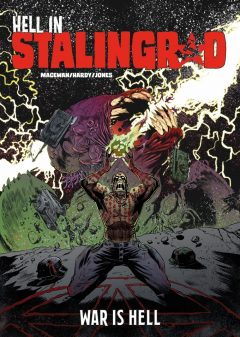Review: Hell in Stalingrad (Mad Robot Comics)
The great thing about comics is they can be such different entities. They can be beautiful, sweet, funny and heart warming. While at the other end of the spectrum they can be dark, harrowing and nightmarish. As you would expect with a name like Hell in Stalingrad, this new book from Rob Jones (Madius Comics) and Matt Hardy (Mad Robot Comics) is most definitely in the latter category as it brings us a harrowing tale of soldiers and satanism in the rubble of one of the second world war’s most bloody conflicts.
 Publisher: Mad Robot Comics
Publisher: Mad Robot Comics
Writer: Rob Jones, Matt Hardy
Artist: Russell MacEwan, WASM
Price: TBC
The book begins in a Russian prison with a secret service officer interviewing a Russian prisoner about an incident during the battle of Stalingrad, years earlier. The story he reveals is one of death, destruction and a demonic presence in the centre of it all.
This is definitely one of those books which benefits from knowing as little as possible about it going in. It’s a book that is pushed forward by the action, which ranges from Commando-esque soldiering to something much darker and more sinister. But it is also under pinned with some great historical context as Jones and Hardy are clearly well versed in the period and the subject. They handle the military elements well, giving everything a very grounded and real level of detail and manage to juxtapose the real world horrors and supernatural horrors perfectly.
However it is also a book which is largely built as a framework for some truly unique artwork. This is our first time seeing the artwork of Russell MacEwan, and his enigmatic co-creator WASM, and it really is something to behold. His style is a maelstrom of rough scratchy lines like Lucy Sullivan in Barking. This is then allied with cut and paste textures and digital paint smears which help to really capture the chaotic nature of the story’s setting.
 It’s not always the easiest art style to follow and at times characters can get lost in the carnage (there is no obvious idea of who is Russian and who is German for example), and the style of art shifts and evolves through the book. But that also plays into the ambiguous nature of the story as both sides get caught up in the mayhem of war. Also if you look closely there is genuine artistry going on underneath the chaos, which a style this needs or else it really is just a mess!
It’s not always the easiest art style to follow and at times characters can get lost in the carnage (there is no obvious idea of who is Russian and who is German for example), and the style of art shifts and evolves through the book. But that also plays into the ambiguous nature of the story as both sides get caught up in the mayhem of war. Also if you look closely there is genuine artistry going on underneath the chaos, which a style this needs or else it really is just a mess!
It also allows the supernatural elements to have this even more sinister and otherworldly quality to them. Shapes and textures are used instead of hard lines and so the amorphous quality of the demonic entities are emphasised. This stops everything from being too ‘real’ and losing the fearsome nature of what is being revealed. Without this, it would feel very much like another Mike Mignola/BPRD wannabe story, but with this more expressionistic approach it feels more like a Bill Sienkiewicz comic or even a Francis Bacon painting.
This is definitely not a book for everyone, as its subject matter and art style is quite challenging and unconventional. However if you are looking for a comic which will make you think, and consider the nature of the medium then this is well worth a look. It manages to capture the true horrors of war along with the horrors of the supernatural in a truly unique way, which makes for a really interesting and thought provoking read, that has a lot more to it hidden underneath it’s chaotic appearance.


